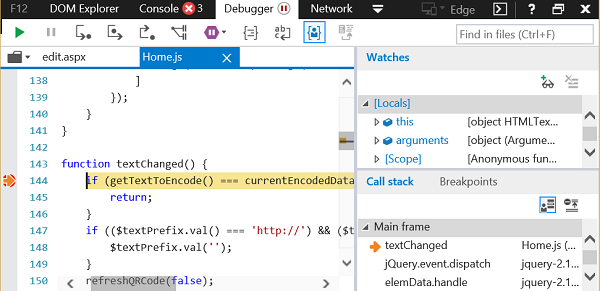
- #DOWNLOAD DEBUGGING TOOLS FOR WINDOWS 7 HOW TO#
- #DOWNLOAD DEBUGGING TOOLS FOR WINDOWS 7 INSTALL#
- #DOWNLOAD DEBUGGING TOOLS FOR WINDOWS 7 DRIVER#
- #DOWNLOAD DEBUGGING TOOLS FOR WINDOWS 7 SOFTWARE#
If all of the above fail, the only left to do is replace your processor as it is faulty.If you work with JavaScript, you’ll know that it doesn’t always play nice.
#DOWNLOAD DEBUGGING TOOLS FOR WINDOWS 7 DRIVER#
You do, but it's not Asus, it's GIGABYTE On/Off Charge driver (AppleCharger.sys). If you have something like this software-wise, remove it ASAP.
#DOWNLOAD DEBUGGING TOOLS FOR WINDOWS 7 SOFTWARE#
The only software conflict that can usually cause *124 bugchecks are OS to BIOS utilities from manufacturer's like Asus' AI Suite. Clear your CMOS (or load optimized BIOS defaults) to ensure there's no improper BIOS setting -Ĥ. You can use a program such as Speccy if you'd like to monitor temps -Ģ.


Ensure your temperatures are within standard and nothing's overheating. There is only so much you can do with a bugcheck like this until it comes down to a faulty processor that will need to be replaced. ^^ We can see the type of error was a cache error, so let's go further:Īs we can see above, more specifically it's related to the L2 Cache on processor #2. If we run an !errrec on the 2nd parameter of the bugcheck (address of the WER structure) we get the following: This fatal error displays data from the Windows Hardware Error Architecture (WHEA). I have uploaded the minidumps to the OneDrive - can you view or do i need to give you access in some way - thakns.īoth of the attached DMP files are of the WHEA_UNCORRECTABLE_ERROR (124) bugcheck.Ī fatal hardware error has occurred.
#DOWNLOAD DEBUGGING TOOLS FOR WINDOWS 7 INSTALL#
Thanks - i have attempted to install the debug tools - no success etc after following instructions to clear the caches etc. If you cannot get into normal mode to do any of this, please do this via Safe Mode. You can do this by right clicking it, selecting properties, and under General selecting startup type to 'Automatic', and then click Apply. Also ensure that under Startup Type it is set to Automatic rather than Manual. Start > Search > type services.msc > Under the name tab, find Windows Error Reporting Service > If the status of the service is not Started then right click it and select Start. Click Advanced System Settings on the left > Advanced > Startup and Recovery > Settings > System Failure > ensure there is a check mark next to 'Write an event to the system log'.Įnsure Small Memory Dump is selected and ensure the path is %systemroot%\Minidump.Ĥ. Click Advanced System Settings on the left > Advanced > Performance > Settings > Advanced > Ensure there's a check-mark for 'Automatically manage paging file size for all drives'.ģ. If not, CTRL-SHIFT-N to make a New Folder and name it Minidump.Ģ. Once inside that folder, ensure there is a Minidump folder created. Start > type %systemroot% which should show the Windows folder, click on it. Please note that any "cleaner" programs such as TuneUp Utilities, CCleaner, etc, by default will delete.
#DOWNLOAD DEBUGGING TOOLS FOR WINDOWS 7 HOW TO#
If you are going to use Onedrive but don't know how to upload to it, please visit the following: Do note that Kernel-Dumps are much larger in size due to containing much more info, which is why I mentioned upload speed, etc. If your upload speed permits it, and you aren't going against any strict bandwidth and/or usage caps, etc, the Kernel-Dump is the bestĬhoice. Much more information at the time of the crash, therefore allowing further debugging of your issue. The differenceīetween Small Memory Dumps and Kernel-Dumps in the simplest definition is a Kernel-Dump contains In %systemroot% there will be what is known as a Kernel-Dump (if your system is set to generate). DMP files located in the Minidump folder are known as Small Memory Dumps.

Nothing with wait-timers.Ĥ (optional): The type of. Prefered sites: Onedrive, Mediafire, Dropbox, etc. DMP files to Onedrive or a hosting site of your choice and paste in your reply. Copy any and all DMP files in the Minidump folder to your Desktop and then zip up these files.ģ. Navigate to the %systemroot%\Minidump folder.Ģ. DMP files are located, here's how to get to them:ġ. DMP files to analyze what exactly occurred at the time of the crash, etc. In order to assist you, we will need the.


 0 kommentar(er)
0 kommentar(er)
